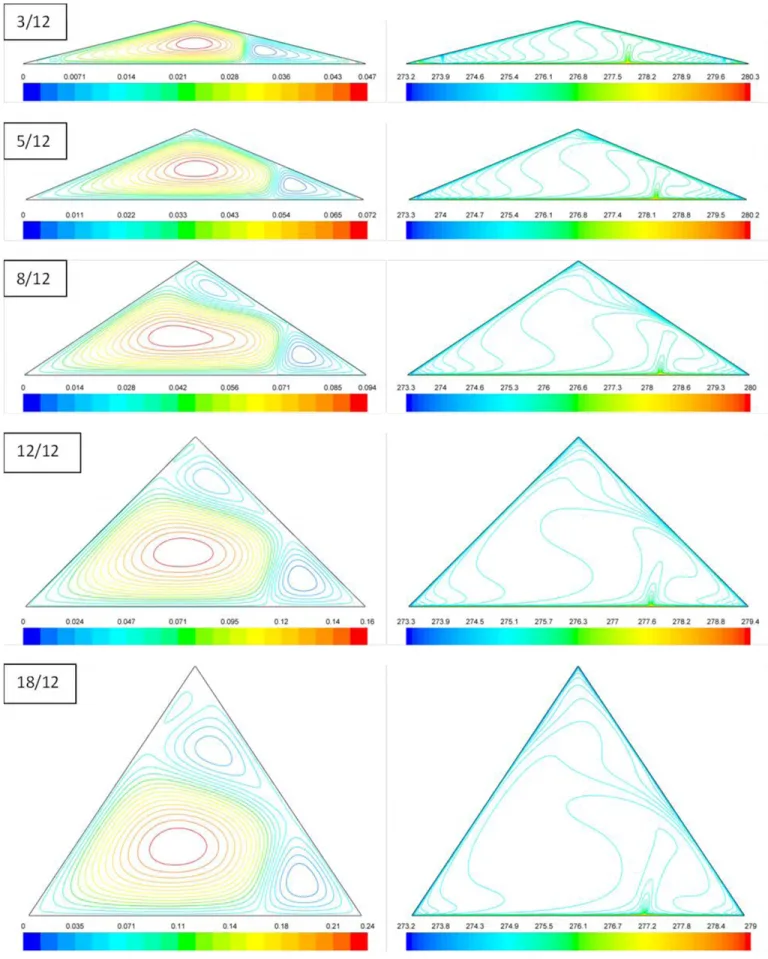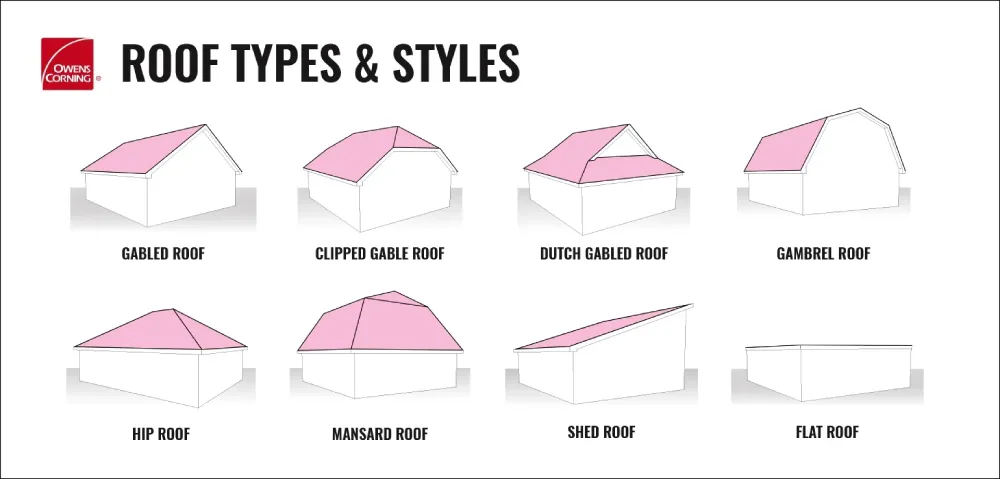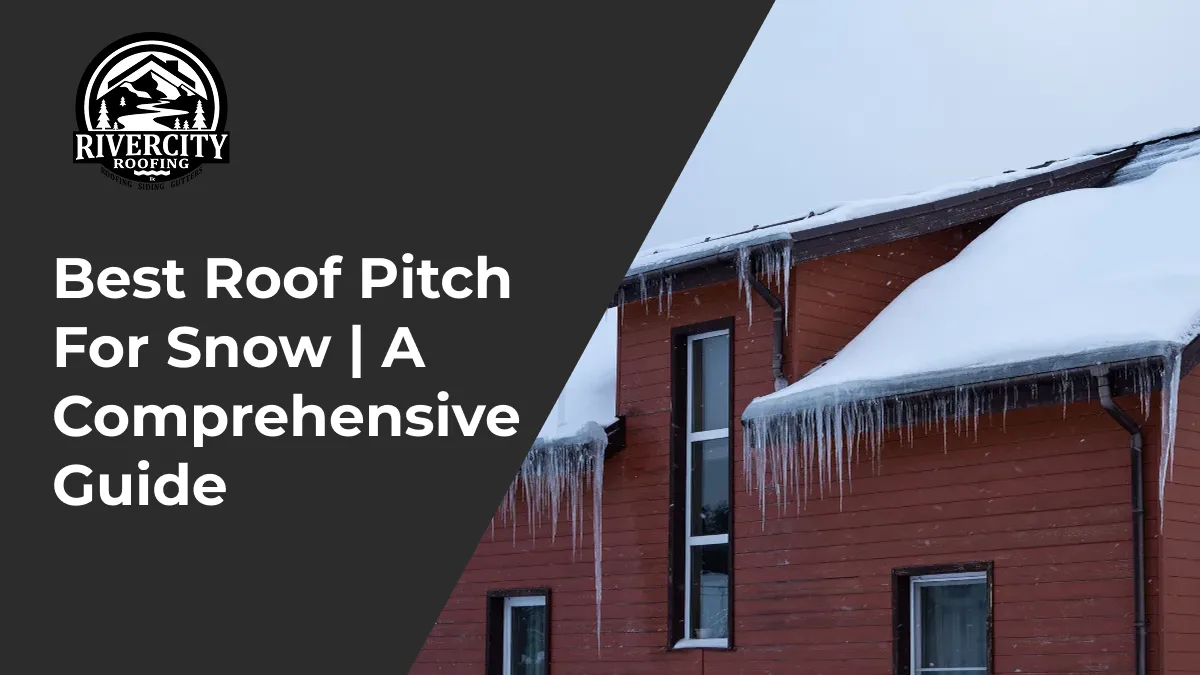Choosing the best roof pitch for snow load is essential for any homeowner in snowy climates. A roof with a 6/12 or steeper pitch helps snow slide off naturally, preventing dangerous accumulation. But what’s the best roof slope for snow in your region? Let’s break it down.
Understanding the impact of freshly fallen snow on snow load and roof safety is essential. Freshly fallen snow, with its varying density, can significantly affect the overall weight and potential hazards for structures.
We’ll explore the optimal roof pitch for snow, examining how different slopes perform under various snow conditions. You may learn of the factors that influence roof performance in snowy climates, from material choices to regional weather patterns.
What is Roof Pitch? How It Affects Snow Load & Safety
Defining roof pitch
Roof pitch nothing but the angle of your roof and can be described as the ratio of your roof vertical compared to horizontal distance. For example, a 4:12 pitch rises 4 inches for every 12 inches of horizontal span. This measurement affects not only the appearance of the roof but also how it handles rain, snow or other elements which can impact its durability and maintenance needs
Steeper roofs allow snow, rain and ice to slide off efficiently. According to FEMA, even a subtle 10-degree pitch (or 2:12) can significantly reduce snow accumulation on a building’s roof. However, an overly steep roof can cause snow to slide off too quickly which could be hazardous below.
Generally, roof pitches between 3:12 and 6:12 are considered ideal for snowy regions. These slopes provide a good balance between snow shedding and safety. pitches prevent dangerous buildups and allow for safer snow removal practices.
How to Calculate Snow Load on Your Roof (Step-by-Step)
Snow load is the downward force exerted on a roof by accumulated snow and ice. Calculating this load is extremely important for ensuring that a structure can withstand winter conditions without risking collapse.
To calculate snow load, you need to consider several factors:
- Ground snow load: This is the amount of snow found on the ground in your area. Building codes provide this information based on historical weather data.
- Roof slope factor: This considers how the roof’s pitch affects snow accumulation.
- Exposure factor: This considers how wind exposure might affect snow distribution on the roof.
- Thermal factor: This accounts for the roof’s heat loss which can cause snow to melt and refreeze.
- Importance factor: This relates to the building’s use and the consequences of failure.
The basic formula for calculating flat roof snow load is:
pf = 0.7 * Ce * Ct * Is * pg
pf = Flat roof snow load, Ce = Exposure factor, Ct = Thermal factor, Is = Importance factor and pg = Ground snow load
For sloped roofs, additional calculations are needed to account for the roof’s angle.
Importance of proper pitch for snow regions
Having the right roof pitch is crucial in snowy regions for several reasons:
- Snow shedding: A proper pitch allows snow to slide off the roof naturally, reducing the load on the structure.
- Preventing ice dams: Adequate slope helps water from melted snow to drain properly, reducing the risk of ice dams forming at the roof’s edge.
- Structural integrity: The right pitch ensures that the roof can handle the expected snow loads without risking collapse.
- Safety: A well-designed roof pitch prevents sudden, dangerous snow slides while still allowing for gradual shedding.
- Energy efficiency: Proper pitch can help with insulation and ventilation, which are particularly important in cold climates. Using a metal roof in snowy regions enhances energy efficiency due to its durability and ability to shed snow efficiently.
- Longevity: A roof that can effectively sheds snow is less likely to suffer from water damage and other snow-related issues which can potentially extend its lifespan.
When designing a roof for these snowy regions, it is important to consider local building codes that often specify minimum pitch requirements based on expected snow loads.
Remember, while a steeper pitch generally sheds snow better, extremely steep roofs can create hazards from rapidly sliding snow.
Note: If you’re looking for Commercial and Residential Roofing Services in Portland, we’d love to help. Contact us, and we’ll design a roof for you that will hold up in the harsh winter months.
Free Roof Inspections. Fast. Reliable.
Is your roof ready to weather the storm? Dont risk property damage. Our free roof inspections provide expert analysis to identify potential issues before they become costly problems.
Why Does Snow Pile Up on Roofs? 3 Key Factors to Know
Snow piling up on your roof isn’t just a winter inconvenience, it can lead to serious problems if you’re not prepared. Here are a few key factors to consider
- Roof Pitch – Steeper roofs (30°+) shed snow better.
- Roof Material – Metal roofs are best for snow, while asphalt requires more maintenance.
- Roof Design – Simple roofs with fewer valleys prevent snow buildup.
Best Roof Pitch for Snow Load

The best roof pitch for snow load varies depending on the amount of snowfall a region experiences. Let’s explore the optimal roof pitches for different snow regions to ensure your roof can handle the winter weather effectively.
| Roof Pitch | Best For | Snow Shedding Ability |
| 2/12 (10°) | Light Snow | Poor (Requires clearing) |
| 3/12 – 4/12 (14°-18°) | Moderate Snow | Moderate (Some accumulation) |
| 6/12 (26°) | Heavy Snow | Good (Balanced shedding) |
| 8/12 – 12/12 (33°-45°) | Extreme Snow | Excellent (Rapid shedding) |
A higher roof pitch helps the snow slide off more often. This means you’ll need to plan carefully to ensure that snow doesn’t shed onto high-traffic areas or building exits.
Regardless of your snow region, it’s crucial to design your roof with simplicity in mind. Avoiding excessive valleys, crickets, dormers, and mechanical roof penetrations can help ensure your roof performs optimally in snowy conditions. Remember, the best roof pitch for snow load is one that balances effective snow shedding with the practical and safety considerations of your specific location and building design.
Factors Affecting Roof Performance in Snowy Conditions
Roofing materials
What roofing material we use matters significantly in a roof’s ability to handle snow. Metals conduct heat efficiently and hence the snow melts off quicker. This also prevents the ice dams from forming again. These also are good at withstanding strong winds so they are perfect for blizzards.
Slate roofs do well in winters also. There is better insulation with this and its also is strong against the heavy snow loads. There are also synthetic slate shingles that are more durable and also energy efficient.
Asphalt shingles is another common choice although these may require frequent repairs. It’s better to install ice and water shields if this material is being used.
Roof design and features

Shed roofs, with their single slope, can also be effective if oriented correctly to facilitate snow shedding. Domed or arched roofs prevent snow accumulation due to their curved shape, encouraging snow to slide off while also offering good wind resistance.
It’s important to note that roofs with valleys, dormers, and other obstructions can cause snow to build up erratically. Simple, straight rooflines are generally more effective at shedding snow and ice.
Insulation and ventilation
Good insulation and ventilation play a huge role in how well your roof holds up during snowy weather. Proper insulation helps keep heat from escaping your home, which is key to avoiding ice dams. When warm air leaks out, it can cause snow on the roof to melt, only to refreeze at the edges, creating those dreaded ice dams. A well-insulated attic, with proper air sealing between heated and unheated spaces, not only prevents this but also saves on energy costs.
Ventilation is just as important, especially in areas with heavy snowfall. It keeps cold air moving through the attic, which helps maintain a consistent roof temperature from top to bottom. This prevents warm spots that could cause snow to melt unevenly and refreeze, leading to ice build-up.
Preventing Ice Dams
Ice dams are a common problem in snowy regions forming when melting snow refreezes at the edge of a roof. Proper ventilation helps maintain roof temperature which stops the uneven melting and the refreezing of the snow hence preventing the formation of these ice dams. Snow guards and cleats are another option. Use a rake or a snow blower, regular cleaning is super helpful in preventing these ice dams. Clearing debris from gutters and downspouts to ensure proper drainage and inspecting the roof for any damage that could impede snow shedding. By taking these preventive measures, you can protect their roofs from the damaging effects of ice dams and ensure their structures remain safe and secure throughout the winter.
Must Read: Can Ice Dams Cause Roof Damage? Understanding the Risks
Regional Snow Load Considerations
Understanding regional snow load requirements is crucial when designing a snow-resistant roof. The State of Oregon Building Codes Division provides an official Snow Load Map Guide that helps homeowners and contractors determine the required roof snow load capacity based on location. Before constructing or modifying a roof, it’s important to check local building codes and regional snow load regulations..
Maintenance and Upkeep
Regular maintenance like clearing debris and gutters ensure that the drainage is good and avoid unnecessary load on the roof. Regular upkeep also ensures that you spot any maintenance that could be needed before it becomes an expensive repair. Installing snow guards or snow cleats can also help prevent snow from suddenly sloughing off the roof, reducing the risk of damage and injury.
By staying proactive with roof maintenance and upkeep you protect your roof from the damaging effects of snow and ice ensuring your homes remain strong and durable in snowy climates.
Conclusion
Making the right decision with the roof pitch is key for a safe building in snowy conditions. Materials used and local snowfall conditions also play a huge role in making a roof that is able to shed snow efficiently and safely, avoiding damage. Hope this article helps in you making the right choice for your home in snowy areas.
Keeping all these factors in mind is key to ensuring your building stays strong and secure in harsh winter conditions. You can create a roof that not only handles heavy snow but also lasts longer and performs better overall.
Need a roof that can withstand heavy snow? Contact our experts today for a customized roofing solution designed for snowy climates!
FAQs
What is the best roof pitch for snow?
The best roof pitch for snow is typically between 6/12 (26.5°) and 12/12 (45°), as these slopes allow snow to slide off easily while maintaining structural stability.
How much snow can a 4/12 pitch roof hold?
A 4/12 roof pitch can hold approximately 20-40 lbs per square foot of snow, depending on its moisture content. Wet snow is heavier and poses more risk than light, dry snow.
What is the best roof pitch for heavy snow?
A 6/12 or steeper pitch is ideal for heavy snow regions, as it allows efficient snow shedding while maintaining structural integrity.
How do I find the snow load requirements for my roof in Oregon?
You can use the Oregon Snow Load Map provided by the Oregon Building Codes Division. This guide explains how to determine the minimum required snow load based on your location.
How Much Snow Can Your Roof Handle?
Your roof’s snow load capacity depends on pitch, material, and regional codes. Use this formula to estimate your roof’s limit:
Roof Snow Load Formula:
pf = 0.7 × Ce × Ct × Is × pg
pf = Flat roof snow load
Ce = Exposure factor
Ct = Thermal factor
Is = Importance factor
pg = Ground snow load
A standard roof can handle 20-40 lbs per square foot, but always check local codes for accurate numbers. For Oregon-specific snow loads, refer to the Oregon Snow Load Map.



